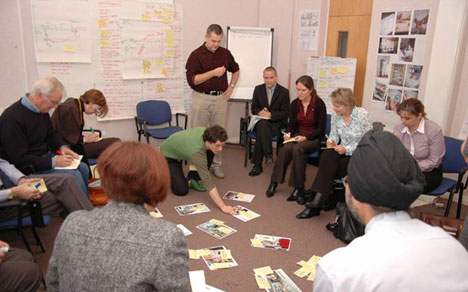Is design political?
 Alex Steffen at WorldChanging points to an excellent essay by RED's Senior Design Strategist, Jennie Wenhall.
Alex Steffen at WorldChanging points to an excellent essay by RED's Senior Design Strategist, Jennie Wenhall.
Jennie asks "Is design political?"
"Design is a very powerful tool. It elevates the likelihood of certain kinds of choices and shapes certain kinds of behaviours. Most designers balk at the idea that design is a form of social engineering, but Hilary Cottam, director of RED at the UK Design Council, maintains that 'if you don't look at what any design is governing, then you are being governed by it.'
She continues: 'The question for us is how do we find out what the effects of design are and make sure we're using those for social justice.' ... So yes, design is political. It's about values, power and preferences, about ideologies and consequences. And the good news is that there's a growing breed of designers who are political with a small p. They're not campaigning, but problem solving; they're not 'master-designers,' but democratic in approach. They're using their skills as designers to illustrate, create and demonstrate opportunities for social change. But the reason for their emergence is that the politics of design itself has changed."
I can certainly identify with Jennie when she says:
My policy colleagues say they went into politics because they wanted to challenge the status quo and make things better for ordinary people. That's certainly why I went into design. So maybe design is more political than you think.
Further:
Crucially, good user-centred designers look at a problem from the point of view of the user, not the priorities of the system, institution or organisation. You could say that user-centred design is a political standpoint in itself. Designers observe people in context to understand the complex experiences, needs and wishes of individuals, and are able to represent and champion those needs throughout the design process.
...
Designers must find new ways of working that enable them to apply their skills where they are most needed - to tackle problems such as chronic health care, climate change and an ageing population.
Her view on the role of designers fits in quite succinctly with my own explorations on the design of democracy.
Wenhall also cites excellent examples of design discipline applied to a host of societal issues -including the IIT Institute of Design's Visible Politics project. (A project koikaze would definitely be interested in.)

1 comment:
It is a wonderful concept, but it does make me wonder about how it is to be achieved.
Design doesn't take place in a vacuum. It is normally a purchased service; the purchaser sets the specifications for the design. This relationship gives us racks of impulse-buying goods at checkout counters (with enough waiting time to induce the buying impulse) and human-enslaving telephone response systems. The only place I can imagine truly human-centric designs are in public works, which are usually driven by some motive other than profit.
This raises the question: If the profit motive is a good basis for economic relationships ... and I believe it is the soundest basis available ... how are we to prevent its excesses? In my opinion, we'll find the answer when we understand that morality is a top-down phenomenon.
I was unable to read the details of "The New" model of the Visible Politics workshop, but I note that one element is "Contextual". That should be an important aspect of any change in political infrastructure. The system I'm familiar with is always fighting the last war.
Fred
Post a Comment